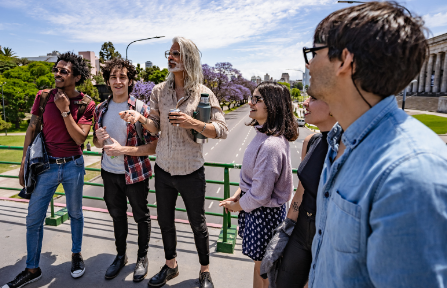How to Enjoy Local Culture Without a Tour Guide or Translator

Traveling to a foreign country where you don’t speak the language or know the customs can be daunting, especially when you’re only in port for a day or two during a cruise. However, you don’t need a tour guide or translator to immerse yourself in the local culture and create memorable experiences. With a bit of preparation, curiosity, and confidence, you can connect with local life in meaningful ways on your own. Whether you’re stopping in a bustling Asian city or a quiet European coastal town, independent exploration can be deeply rewarding.
Start With Some Light Research
Before your ship docks, take some time to learn a few basics about your destination. A general understanding of the local history, traditions, and etiquette can make a world of difference in how you experience the culture. Focus on simple greetings, gestures, and customs—what’s considered polite or impolite can vary significantly from place to place.
For example, if your cruise includes a stop in Japan, learning a respectful bow or how to say “thank you” in Japanese (arigatou gozaimasu) can go a long way. On many Japan cruises, you’ll find that even in larger ports like Yokohama or Kobe, the locals appreciate small efforts from visitors trying to engage respectfully with their culture.
Use Visual and Contextual Clues
You don’t need to speak the language to understand what’s happening around you. Many places have universal signs or pictograms to help guide travelers, especially in areas that regularly welcome tourists. From menu photos at restaurants to directional signs with icons at bus stops and train stations, visuals often bridge the language gap.
When you’re unsure of something, watch what locals do. If you’re waiting in line at a food stall, observe how others order and pay. If you’re in a temple or shrine, look at how others behave—do they remove their shoes, bow, or offer coins? Context and body language often give more information than words.
Use Translation Apps and Offline Tools
While it’s possible to enjoy a destination without a translator, having a smartphone with the right tools can be a safety net. Google Translate, for instance, has a camera function that translates signs and menus in real time. Some apps even allow you to download language packs, which is especially helpful when you don’t have internet access in port.
If you prefer a tech-free approach, a small phrasebook or a printout of essential phrases and place names in the local language can help. Consider writing down your port name in the native script in case you need to find your way back.
Embrace Street Food and Local Markets
Street vendors and open-air markets are perfect places to experience local culture without needing much verbal interaction. You can often point to what you want, pay with local currency, and enjoy the authentic flavors of the region. The sensory experiences—aromas, textures, sounds—offer a deeper understanding of the community than a guided restaurant meal might.
Markets also give insight into daily life. You’ll see what locals buy, what’s in season, and how people interact in their routines. Don’t be afraid to make small purchases or ask, using gestures or simple English, about unfamiliar items. Vendors are usually welcoming, especially if you’re polite and open-minded.
Use Walking as a Cultural Tool
Exploring on foot gives you the time and flexibility to absorb your surroundings more fully. In many cruise ports, the most interesting areas are compact enough to walk. As you meander through neighborhoods, notice the architecture, signage, community spaces, and how people spend their time.
In places like Kanazawa or Hakodate—common stops on Japan cruises—you can stroll through old samurai districts, local parks, or seafood markets, getting an unfiltered look at daily life. These walks can often lead to unexpected finds: a local festival, a craft shop, or a serene garden tucked behind a narrow street.
Visit Local Libraries, Museums, and Temples
Even without a translator, cultural institutions can provide a lot of insight. Many museums and historical sites offer English signage or brochures, and even those that don’t often feature visual displays or interactive exhibits that are self-explanatory. Libraries and bookstores, while less conventional for tourists, can be peaceful places to observe or even interact with locals.
Temples and religious sites are also rich with cultural context. Just being present and quiet in these places allows for observation and reflection. You might see rituals, offerings, or celebrations unique to the area.
Make Connections Through Shared Interests
Whether it’s photography, art, coffee, or cycling, shared hobbies can create bridges between people without relying heavily on language. Seek out local art galleries, bike rental shops, or small cafés where enthusiasts gather. These environments often foster informal communication and a sense of belonging, even for a short visit.
In many Japanese cities, for example, small local cafés or bookstores often host community events or have message boards with upcoming cultural happenings. Even if you don’t attend a formal event, just entering the space where locals spend their free time allows for cultural immersion.
Stay Curious and Flexible
Perhaps the most important tip is to stay open-minded. Not everything will go smoothly—sometimes you might order something unexpected at a restaurant or find yourself on the wrong street. But these small misadventures often become the most cherished memories of a trip. A smile, respectful gestures, and willingness to learn can often outweigh the lack of a common language.
Traveling without a guide or translator encourages you to engage more actively with your environment. You begin to notice more, question more, and reflect more deeply. While guided tours have their place, the joy of independent exploration lies in its unpredictability and authenticity.
Whether you’re docking in a serene Japanese port or wandering the cobbled streets of a Mediterranean town, your willingness to engage with local culture directly—and humbly—can lead to a richer travel experience. After all, the world doesn’t require fluency to be appreciated. Sometimes, all it takes is curiosity, respect, and a sense of adventure.





